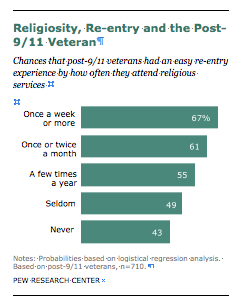Army Major David Lile of the 3rd Infantry Division prays during a 2010 Memorial Day observance in Iraq
So of all the elements that can cushion a soldier’s return to civilian life from Afghanistan and Iraq, what’s the most important? Well, according to a new report from the Pew Research Center, it’s a soldier’s faith, or the lack thereof, that exerts the most positive impact on how he or she will fare upon returning to the civilian world:
Higher levels of religious belief, as measured by frequent attendance at religious services, dramatically increases the odds that a post-9/11 veteran will have an easier time readjusting to civilian life. According to the analysis, a recent veteran who attends religious services at least once a week has a 67 percent chance of having an easy re-entry experience. Among post-9/11 veterans who never attend services, the probability drops to 43%.
You knew there was a reason they call it the Pew center, right?
(Actually, no – the outfit thrives thanks to the generosity of the Pew Charitable Trusts, funded by the children of Sun Oil Co. founder Joseph Pew and his wife, Mary.)
Pew’s latest military-related study, based on a survey of 1,853 veterans (including 710 post-9/11 vets), found that 27% of veterans had difficulty readjusting to civilian life. But that share soared to 44% for those veterans who have served since 9/11. While the study offered no conclusion as to why recent veterans seem to be having more trouble than older vets, it suggested that recent vets’ woes and recollections are more fresh in their minds and could account for at least some of the increase.
Pew’s Rich Morin looked at 18 factors to see if they helped or hurt veterans land softly back in the civilian world.
Turns out four factors made for an easier readjustment, while six predicted a tougher landing (the percentage-point changes represent the likelihood that a veteran with each characteristic had an easy time re-entering civilianland).
It’s easier for a veteran to return home if the veteran:
— is a college graduate (5 percentage-point improvement)
— was an officer (10 percentage-point improvement)
— had a clear understanding of the military mission (10 percentage-point improvement)
— is religious (24 percentage-point improvement among post-9/11 vets; insignificant difference for older vets)
Things that made integration tougher were:
— Knew someone killed or injured (6 percentage-point penalty)
— Served in combat (7 percentage-point penalty)
— Served post-9/11 (15 percentage-point penalty)
— Served post-9/11 and was married (15 percentage-point penalty, likely due to strains in the relationship caused by deployment)
— Was seriously injured (19 percentage-point penalty)
— Experienced a traumatic event (26 percentage-point penalty)
Troops suffering from post-traumatic stress had a tougher time re-integrating. Eighty-two percent of veterans without PTS said they had an easy re-entry; that fell to 34% for those with PTS. Pew also found that a veteran’s number of combat deployments had no statistically significant relationship to how well he or she did in returning to civilian life.



